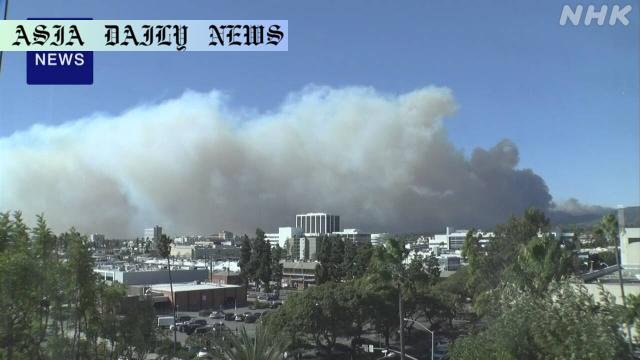Wildfires have been contained in California after over three weeks, causing significant destruction and loss of 29 lives.
Wildfires near Los Angeles have been contained after three weeks.
The disaster caused significant damage to homes and infrastructure.
29 fatalities have been confirmed, and recovery efforts have begun.
Concerns remain about hazardous substances in the affected areas.

Introduction: Devastating Wildfires in Los Angeles
The state of California has once again faced the wrath of nature, as devastating wildfires erupted near Los Angeles, claiming 29 lives and causing widespread destruction. Officials announced on Friday that the fires, which had been raging for over three weeks, have finally been contained. This disaster has left behind a trail of destruction, damaging over 18,000 structures and engulfing more than 200 square kilometers of land. As attention shifts to recovery and reconstruction, the scale of the task ahead is enormous.
Impact on Pacific Palisades and Altadena Communities
The wildfires have severely impacted the coastal Pacific Palisades neighborhood and the inland community of Altadena. In Pacific Palisades, the picturesque setting has been scarred by the flames, with homes and infrastructure being reduced to ashes. Altadena, known for its inland beauty, has also suffered severe damage, with residents reeling from the devastation. Many families have lost their homes, and entire neighborhoods now stand deserted, waiting for rebuilding efforts to begin. This disaster underscores the vulnerability of communities to increasingly intense wildfires.
Containment Achieved but Challenges Persist
While fire officials have confirmed that the wildfires are now contained, the journey to recovery is far from over. Containment does not erase the scars left by the disaster, nor does it resolve the challenges posed by hazardous remnants such as ash and potentially toxic substances. Cleanup crews are working tirelessly to clear debris, but the scale of destruction will require months, if not years, of coordinated efforts to rebuild homes, infrastructure, and public spaces. The immediate priority is restoring electricity, water supply, and basic amenities to the affected areas.
Health and Environmental Concerns
One of the greatest concerns following the wildfires is the potential exposure to hazardous substances left behind by the blaze. The ash and debris may contain harmful chemicals, posing a risk to both humans and the environment. Residents returning to their homes have been advised to exercise caution and wear protective gear. Environmental experts are closely monitoring air and soil quality to assess the long-term impact of the disaster. Addressing these concerns will require collaboration between local authorities, environmental agencies, and community organizations.
The Path to Recovery and Reconstruction
Los Angeles Mayor Karen Bass announced that restrictions on access to the Pacific Palisades area will be lifted on Sunday. However, the return to normalcy will take time. Recovery efforts will involve not only rebuilding homes but also addressing the emotional and psychological toll on residents. Many families have lost loved ones, and the trauma of witnessing such destruction will linger for years. Community support programs, counseling services, and financial assistance will play a crucial role in helping affected individuals rebuild their lives.
Climate Change and Wildfire Preparedness
The increasing frequency and intensity of wildfires in California and other parts of the world highlight the urgent need to address climate change. Rising temperatures, prolonged droughts, and changing weather patterns have created a perfect storm for such disasters. Governments and communities must invest in wildfire prevention, early warning systems, and sustainable practices to mitigate the risks. Strengthening infrastructure and building fire-resistant homes are essential steps in reducing vulnerability to future wildfires.
Conclusion: Lessons From Tragedy
The recent wildfires near Los Angeles serve as a stark reminder of the destructive power of nature and the need for preparedness. As recovery efforts get underway, it is crucial to focus on building resilience and learning from this tragedy. The affected communities have displayed remarkable strength and unity in the face of adversity, offering hope for a brighter future. However, it will take the combined efforts of government agencies, local organizations, and residents to rebuild and recover fully. Addressing the root causes of wildfires, such as climate change, is essential to prevent similar disasters in the future.
Commentary
The Human Cost of Wildfires
The devastating wildfires near Los Angeles have once again reminded us of the human cost of natural disasters. The loss of 29 lives is a stark tragedy that cannot be overlooked. Beyond statistics, these are families and communities torn apart by the fiery destruction. The trauma of losing loved ones, homes, and cherished memories will weigh heavily on the affected residents for years to come. As we extend our condolences to the victims, it is also a moment to reflect on how we can better support those enduring such crises.
The Environmental Toll
Wildfires not only devastate communities but also leave a significant imprint on the environment. The scars left on the landscape, the loss of biodiversity, and the release of harmful substances into the air and soil are alarming concerns. This tragedy is a wake-up call for policymakers and environmentalists to take proactive steps in fire prevention and sustainable land management. We must prioritize reforestation, soil restoration, and measures to mitigate the long-term impact on California’s ecosystems.
Addressing Climate Change
It is impossible to discuss wildfires without addressing the role of climate change. The rising incidence of catastrophic fires is a symptom of a larger, more pervasive problem affecting the planet. Prolonged droughts, extreme heatwaves, and unpredictable weather patterns are making regions increasingly susceptible to wildfires. Governments and individuals alike must take action to reduce carbon emissions, support renewable energy, and push for international collaboration to combat global warming. The time to act is now before such tragedies become even more frequent and severe.


